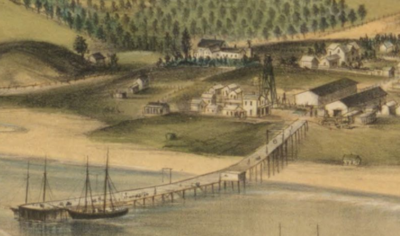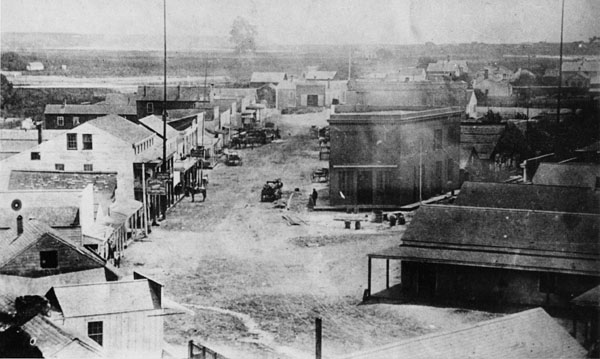History Pages: 18 - Antebellum
For a table of contents, see History pages.
As we well know, the local economy goes through booms and busts. Santa Cruz had two booms and one bust in the 1850s. The first boom began with the 1848 Gold Rush. Then, the first half of the new decade saw a slump as the influx of miners slowed to a trickle. The slump was most acutely felt by the potato farmers, who had been exporting huge shipments of the tubers to feed the hungry 49ers. There were stories of potatoes left to rot in the fields because they couldn't be sold. Business picked up again, however, in the second half of the decade as locals returned with their sacks of gold dust and gold rush immigrants from other states and countries looked for places to settle down in California.
Many new ships, especially the new steamships, were built to carry supplies along the coast to San Francisco, and up the Sacramento River to the gold country. The expansion of shipping traffic proved to be permanent, and coastal towns like Santa Cruz saw an increase in maritime trade. The Anthony Wharf (now owned and expanded by Davis & Jordan Lime and Cement) proved inadequate to handle the increased traffic, so in 1857 David Gharkey led the effort to build a second wharf. Gharkey was one of those 49ers who came to California for the gold and ended up here, apparently with some money to spend. His wharf began from about the intersection of today’s Main and 1st streets on Beach Hill, and was sold to the California Powder Co. in 1865. According to Clark, Gharkey came originally from Ohio, died in 1877, and is buried in Evergreen Cemetery. He’s remembered on the signs of Gharkey Street on the Westside.
[Note: There were several different spellings of the name in local sources. I did a little genealogy research on the Ohio family, and found that the original spelling was the German Gherke.]
The end-of-decade growth also brought two newcomers fated to become closely connected in later years. One of these was a newspaper. The Pacific Sentinel moved north from Monterey in 1856, and stayed on to become the area’s oldest newspaper. Although still called the Santa Cruz Sentinel, the paper is no longer locally-owned.
The other 1856 arrival was the McPherson family, from New York by way of the Placerville gold fields. Sixteen-year-old Duncan grew up to become an employee and eventually owner of the Sentinel, and the McPherson family became one of the names most associated with civic activity in Santa Cruz.
By 1860, when F. A. Hihn’s brother Hugo (who kept the German spelling of the name - Hühn) built the two-story brick “Flatiron” Building at the tip of the block where Main and Willow Streets (today’s Front and Pacific) met, the Santa Cruz business center had definitely shifted down the hill from the Mission Plaza (see photo). Although Davis & Jordan had been shipping lime to make mortar since 1853, it took awhile for brick (non-adobe) buildings to catch on here. The Flatiron Building was possibly the first in town – certainly the only one in the 1860s photo. The building activity of that year was soon to be interrupted by a different kind of calamity - the Civil War.

